Summary
19F nuclear magnetic resonance (NMR) imaging and19F NMR chemical-shift imaging (19F CSI) have been used to localize fluorinated compounds administered to stems ofAncistrocladus heyneanus andA. abbreviatus for the elucidation of biosynthetic pathways in living plants. This first application of19F CSI on plants proved CSI to be a valuable technique for mapping fluorinated molecules in plants. Exemplarily using trifluoroacetate as a model compound allowed to select appropriate feeding methods and to optimize both concentration and duration of the application to the plant. The time course of the uptake and distribution of trifluoroacetate was monitored by both19F imaging and19F CSI. Fluorinated metabolites formed by uptake of 3-fluoro-3-deoxy-D-glucose were detected with19F CSI.
Similar content being viewed by others
Abbreviations
- 3-FDG:
-
3-fluoro-3-deoxy-D-glucose
- CSI:
-
chemicalshift imaging
- NMR:
-
nuclear magnetic resonance
- SNR:
-
signal-to-noise ratio
- TFA:
-
trifluoroacetate
References
Berkowitz BA, Moriyama T, Fales HM, Byrd RA, Balaban RS (1990) In vivo metabolism of 3-FDG. J Biol Chem 265: 12417–12423
Bringmann G, Pokorny F (1995) The naphthylisoquinoline alkaloids. In: Cordell GA (ed) The alkaloids, vol 46. Academic Press, New York, pp 127–271
— Schneider C, Pokorny F, Lorenz H, Fleischmann H, Sankara Narayanan AS, Almeida MR, Govindachari TR, Aké Assi L (1993) The cultivation of tropical lianas of the genusAncistrocladus. Planta Med 59 Suppl: 623–624
— Rischer H, Schlauer J, Aké Assi L (1999) In vitro propagation ofAncistrocladus abbreviatus Airy Shaw (Ancistrocladaceae). Plant Cell Tissue Organ Cult 57: 71–73
— Wohlfarth M, Rischer H, Grüne M, Schlauer J (2000) A new biosynthetic pathway to alkaloids in plants: acetogenic isoquinolines. Angew Chem Int Ed 39: 1464–1466
Brown TR, Kincaid BM, Ugurbil K (1982) Chemical shift imaging in three dimensions. Proc Natl Acad Sci USA 79: 3523–3526
Callaghan PT (1991) Principles of nuclear magnetic resonance microscopy. Clarendon Press, Oxford
Chudek JA, Hunter G (1997) Magnetic resonance imaging of plants. Progr NMR Spectrosc 31: 43–62
Connelly A, Lohman JAB, Loughman BC, Quiquampoix H, Ratcliffe RG (1987) High resolution imaging of plant tissues by NMR. J Exp Bot 38: 1713–1723
Frank H, Klein A, Renschen D (1996) Environmental trifluoroacetate. Nature 382: 34
Gadian DG (1995) NMR and its applications to living systems. Oxford University Press, Oxford
Glidewell SM, Williamson B, Duncan GH, Chudek JA, Hunter G (1999) The development of blackcurrant fruit from flower to maturity: a comparative study by 3 D nuclear magnetic resonance (NMR) micro-imaging and conventional histology. New Phytol 141: 85–98
Heidenreich M, Köckenberger W, Kimmich R, Chandrakumar N, Bowtell R (1998) Investigation of carbohydrate metabolism and transport in castor bean seedlings by cyclic J cross polarization imaging and spectroscopy. J Magn Reson 132: 109–124
Kent PW, Dwek RA, Taylor NF (1971) Conflgurational dependencies of19F-shifts in fluoromonosaccharides. Tetrahedron 27: 3887–3891
Kuchenbrod E, Haase A, Benkert R, Schneider H, Zimmermann U (1995) Quantitative NMR microscopy on intact plants. Magn Reson Imaging 13: 447–455
Maudsley AA, Hilal SK, Perman WH, Simon HE (1983) Spatially resolved high resolution spectroscopy by four-dimensional NMR. J Magn Reson 51: 147–152
Mc Fall JS, Johnson GA (1994) The architecture of plant vasculature and transport as seen with magnetic resonance microscopy. Can J Bot 72: 1561–1573
Meininger M, Jakob PM, von Kienlin M, Koppler D, Bringmann G, Haase A (1997) Radial spectroscopic imaging. J Magn Reson 125: 325–331
— Stowasser R, Jakob PM, Schneider H, Koppler D, Bringmann G, Zimmermann U, Haase A (1997) Nuclear magnetic resonance microscopy ofAncistrocladus heyneanus. Protoplasma 198: 210–217
Metzler A, Izquierdo M, Ziegler A, Köckenberger W, Komor E, von Kienlin M, Haase A (1995) Plant histochemistry by correlation peak imaging. Proc Natl Acad Sci USA 92: 11912–11915
— Köckenberger W, von Kienlin M, Komor E, Haase A (1994) Quantitative measurement of sucrose distribution inRicinus communis seedlings by chemical-shift microscopy. J Magn Reson B 105: 249–252
Olt S, Krötz E, Komor E, Rokitta M, Haase A (2000)23Na and1H NMR microimaging of intact plants. J Magn Reson 144: 297–304
Phillips L, Wray V (1971) Stereospecific electronegative effects, part I: the19F nuclear magnetic resonance spectra of deoxyfluoro-D-glucopyranoses. J Chem Soc B: 1618–1624
Pohmann R, von Kienlin M, Haase A (1997) Theoretical evaluation and comparison of fast chemical shift imaging methods. J Magn Reson 129: 145–160
Ratcliffe RG (1994) In vivo NMR studies of higher plants and algae. In: Callow JA (ed) Advances in botanical research, vol 20. Academic Press, London, pp 44–123
Rokitta M, Zimmermann U, Haase A (1999) Fast flow measurements in plants using FLASH imaging. J Magn Reson 137: 29–32
— Peuke AD, Zimmermann U, Haase A (1999) Dynamic studies of phloem and xylem flow in fully differentiated plants using fast NMR microimaging. Protoplasma 209: 126–131
Rollins A, Barber J, Elliott R, Wood B (1989) Xenobiotic monitoring in plants by19F and1H nuclear magnetic imaging and spectroscopy. Plant Physiol 91: 1243–1246
Rowland IJ, Maxwell RJ, Collins DJ, Howe FA, Leach MO, Griffiths JR, O'Hagan D (1993) Natural abundance fluorine imaging. Proc Soc Magn Reson Med 2: 894
Wolf K, van der Toorn A, Hartmann K, Schreiber L, Schwab W, Haase A, Bringmann G (2000) Double quantum chemical shift imaging for metabolite monitoring in plants. J Exp Bot 353: 1–9
Wyrwicz AM, Pszenny MH, Schofleld JC, Tillman PC, Gordon RE, Martin PA (1983) Applications of19F NMR spectroscopy to studies on intact tissues. Science 222: 428–430
— Ryback KR, Chew W, Hurd R (1986)19F NMR imaging of a fluorinated anesthetic in a model system. J Magn Reson 69: 572–575
Ziegler A, Metzler A, Köckenberger W, Izquierdo M, Komor E, Haase A, Décorps M, von Kienlin M (1996) Correlation-peak imaging. J Magn Reson B 112: 141–150
Author information
Authors and Affiliations
Additional information
Dedicated to Professor Manfred Christi on the occasion of his 60th birthday
Rights and permissions
About this article
Cite this article
Bringmann, G., Wolf, K., Meininger, M. et al. In vivo19F NMR chemical-shift imaging ofAncistrocladus species. Protoplasma 218, 134–143 (2001). https://doi.org/10.1007/BF01306603
Received:
Accepted:
Issue Date:
DOI: https://doi.org/10.1007/BF01306603




